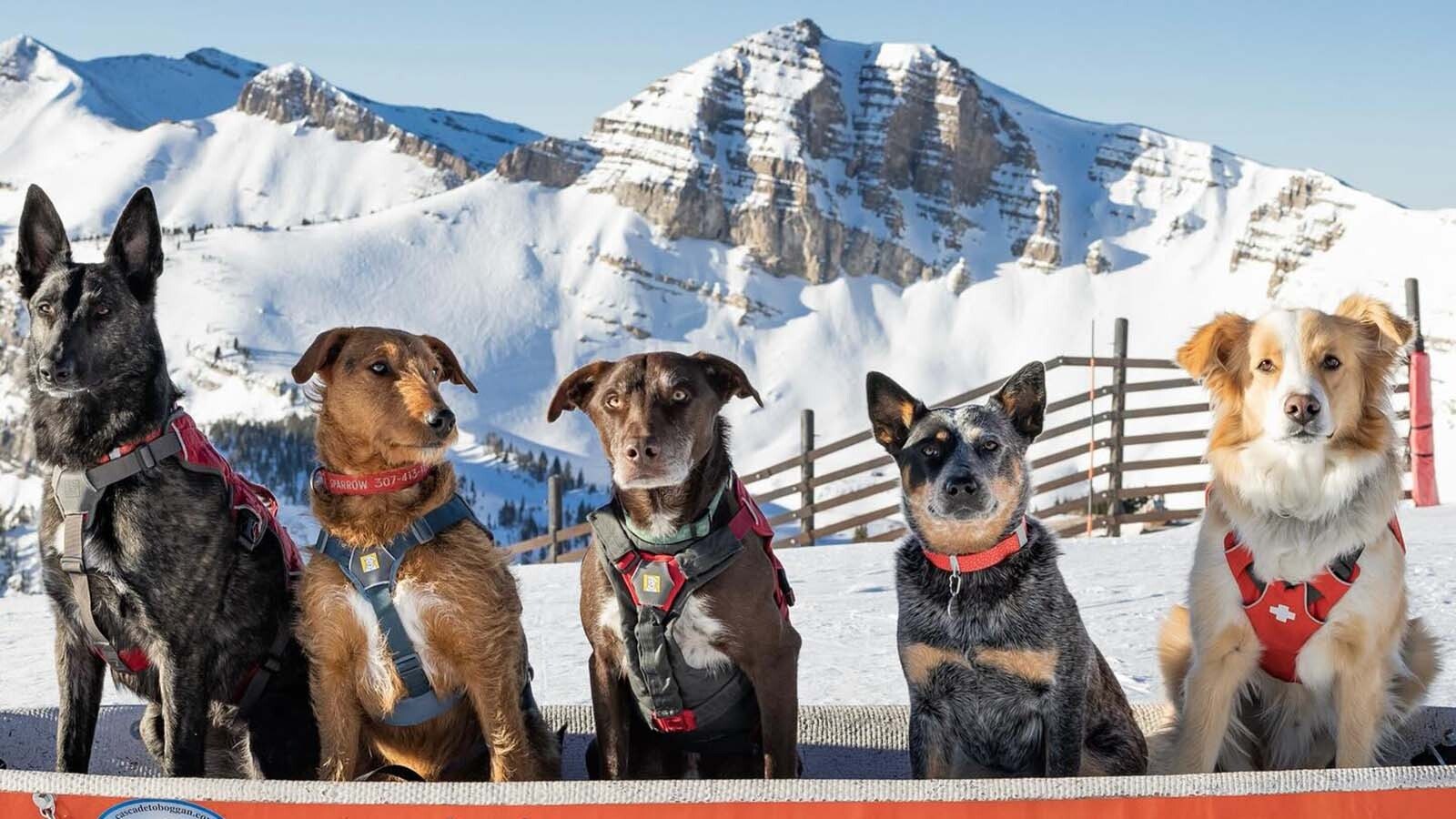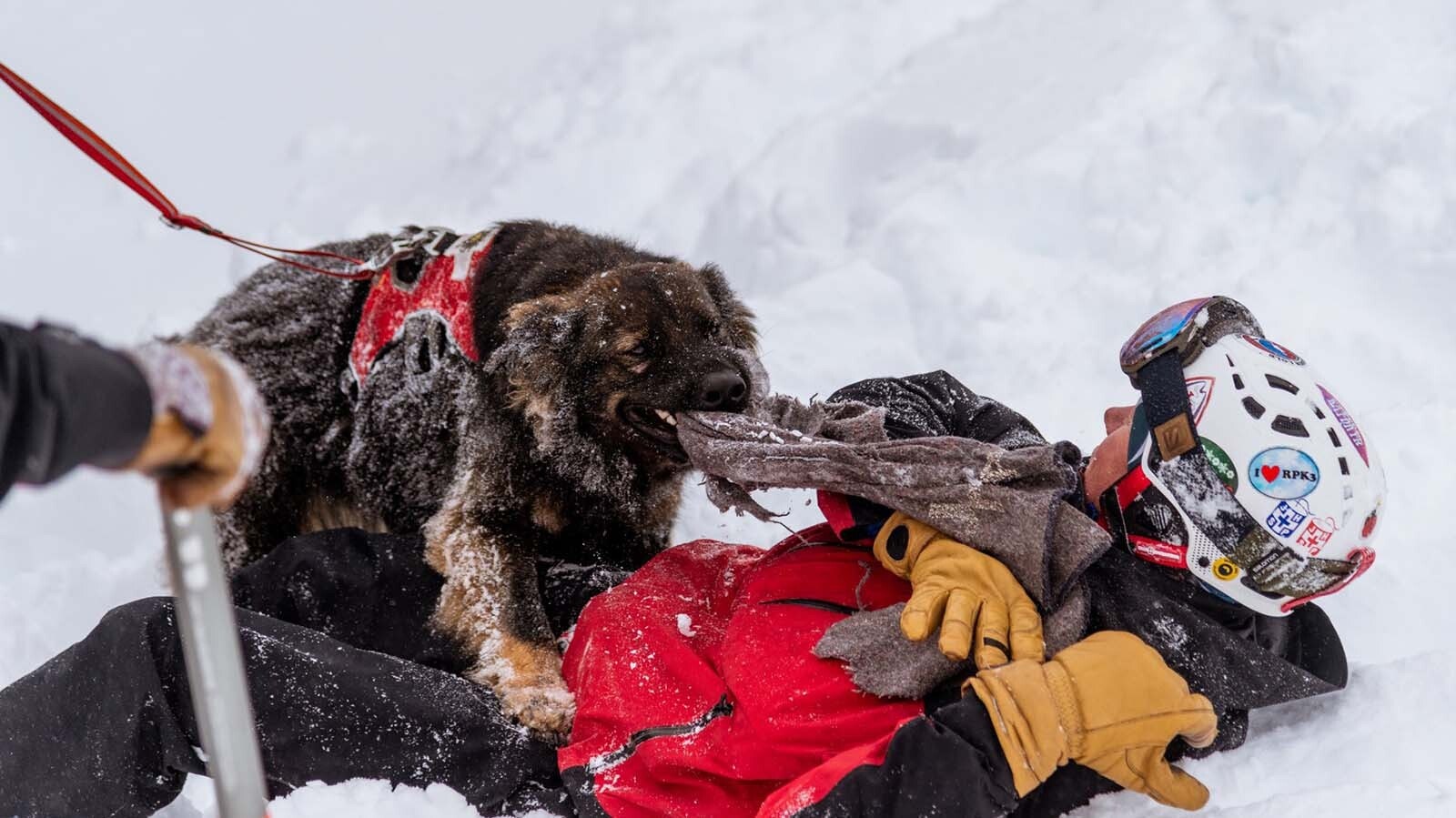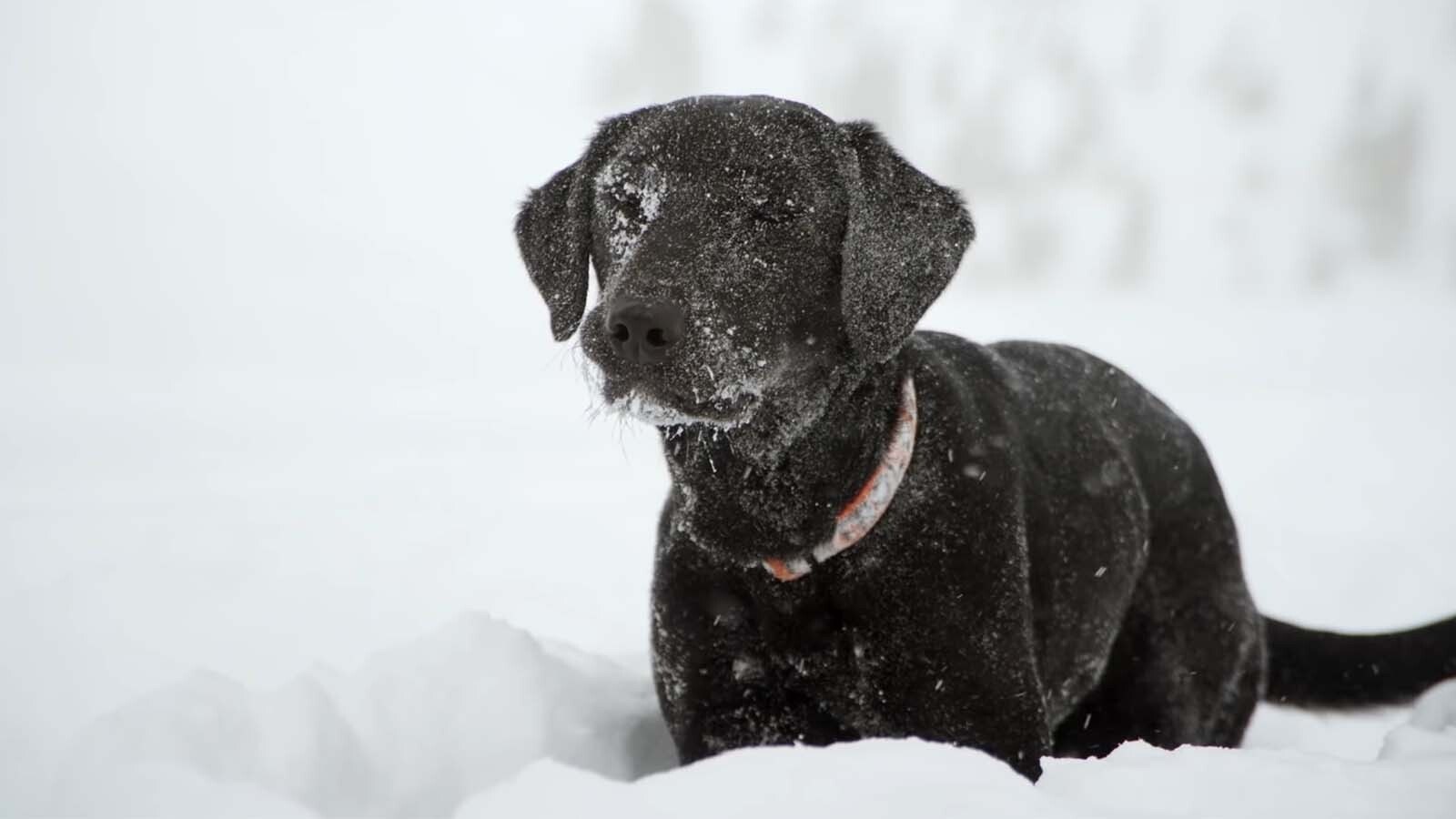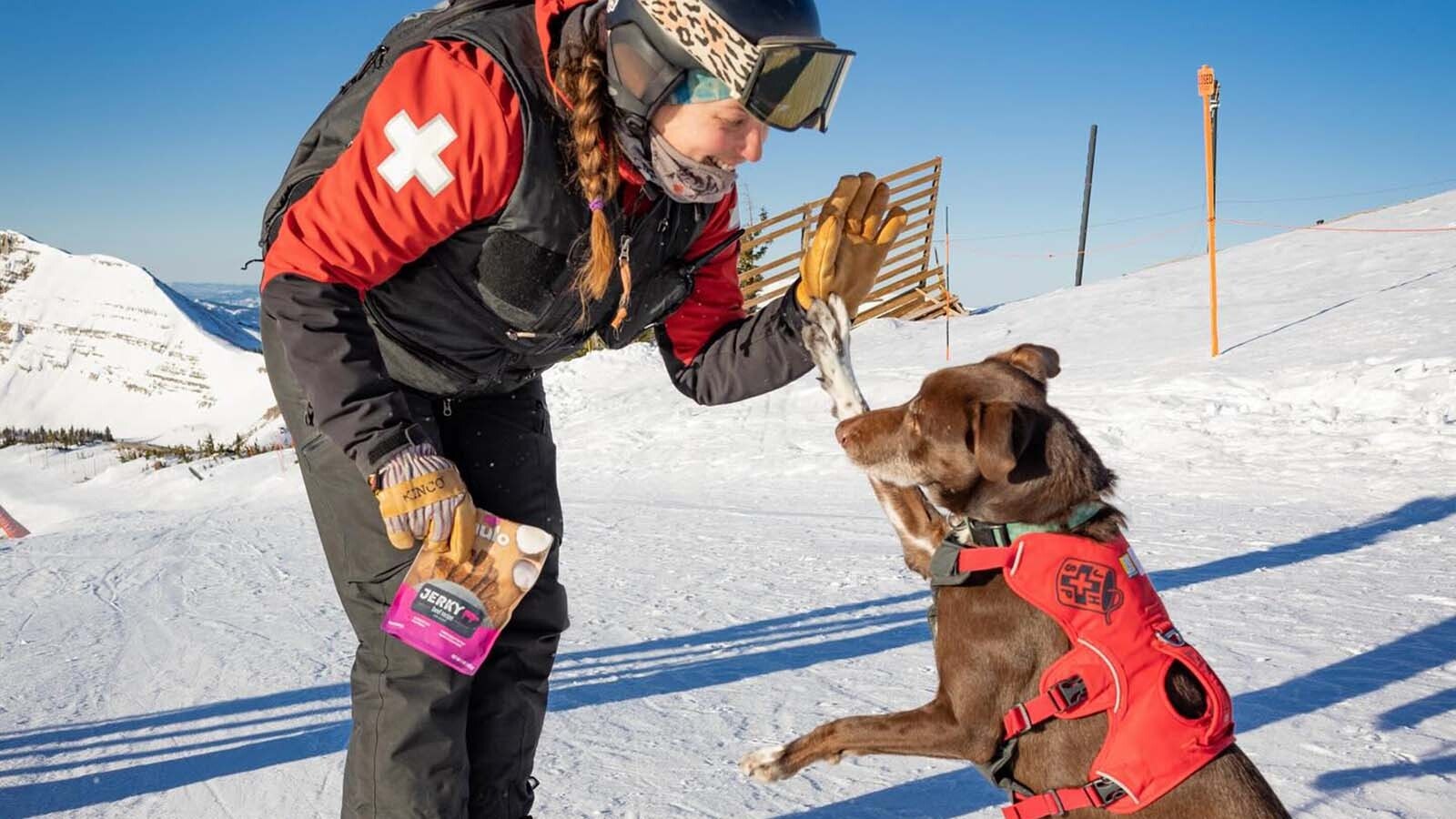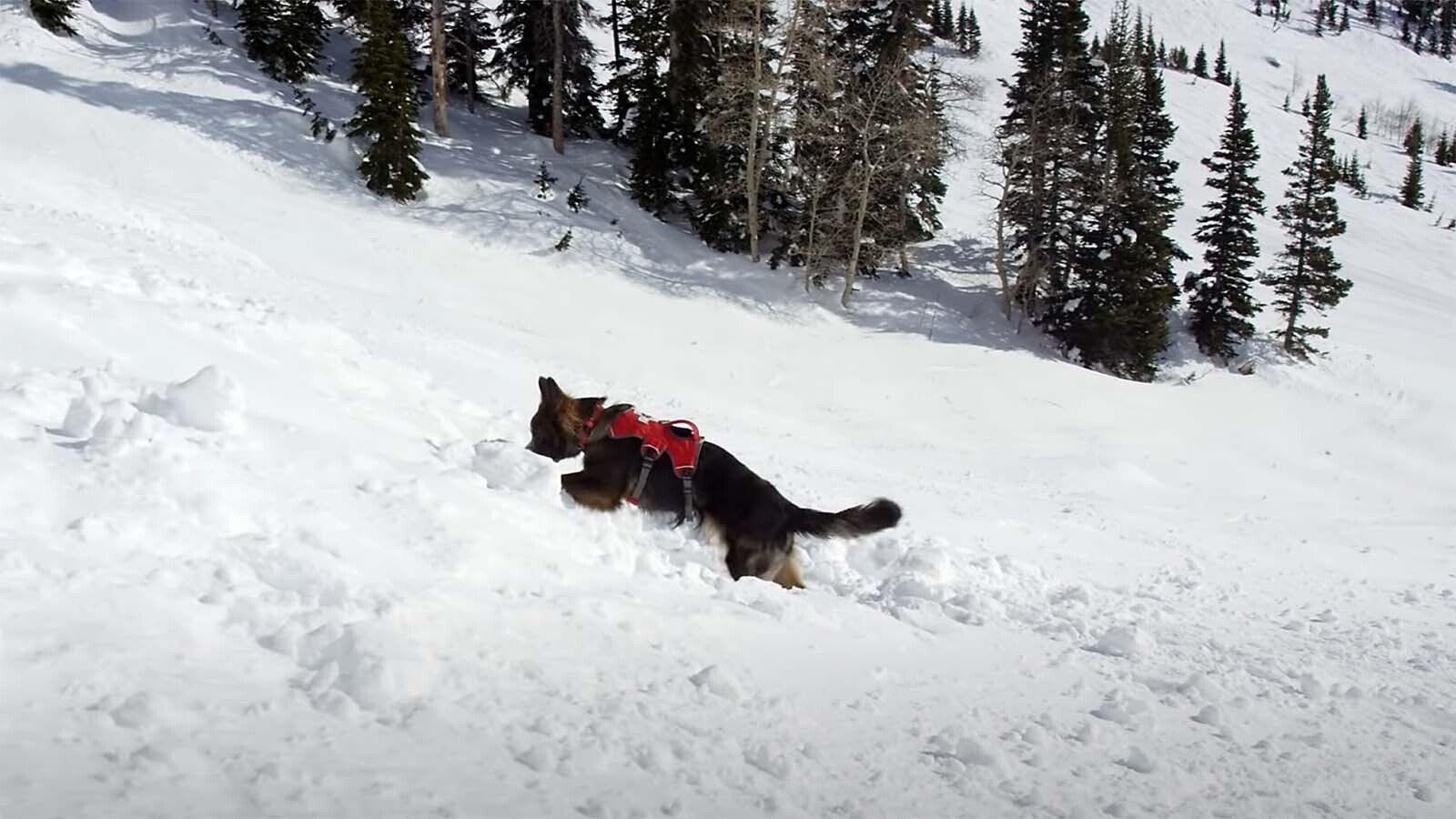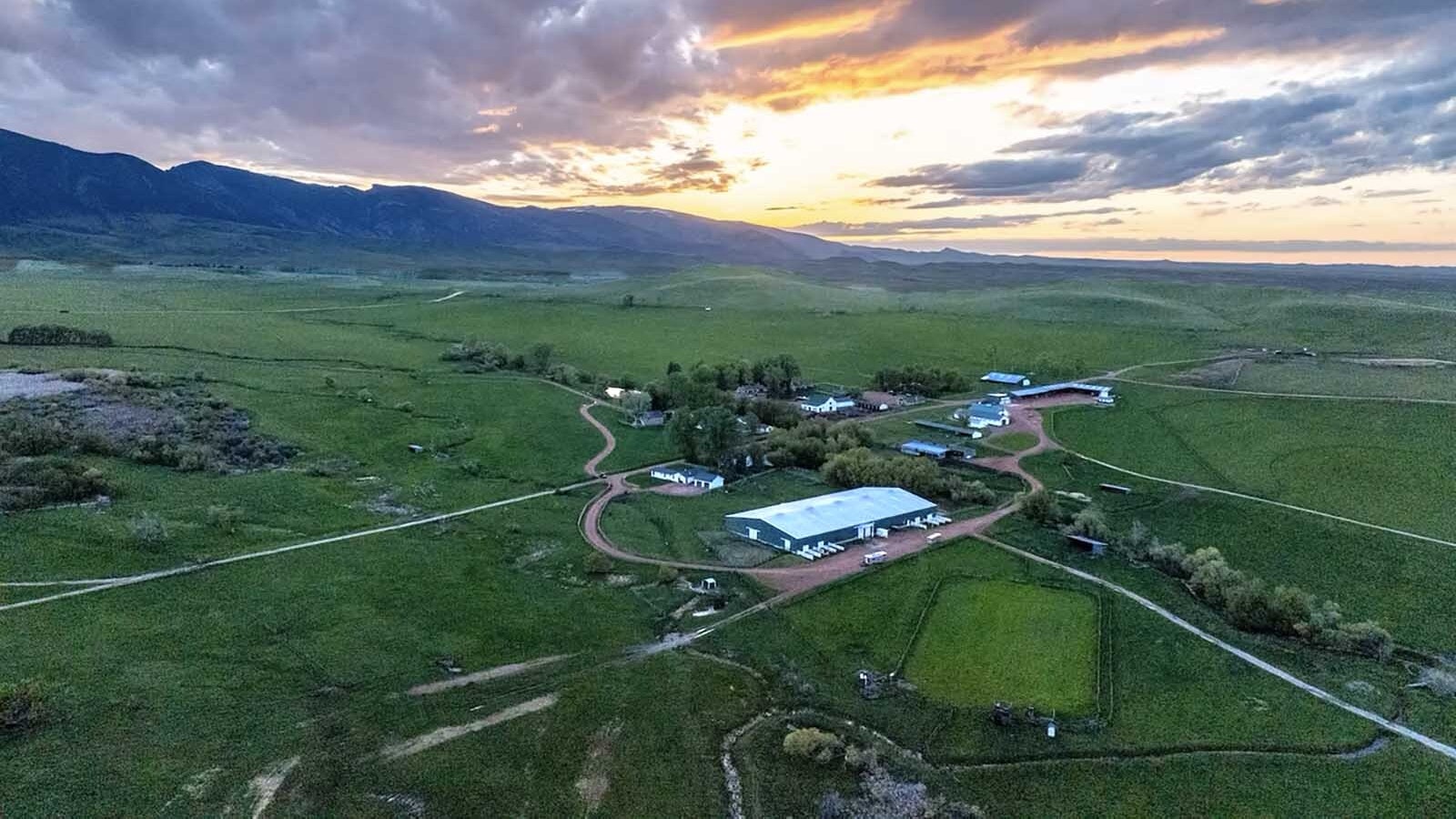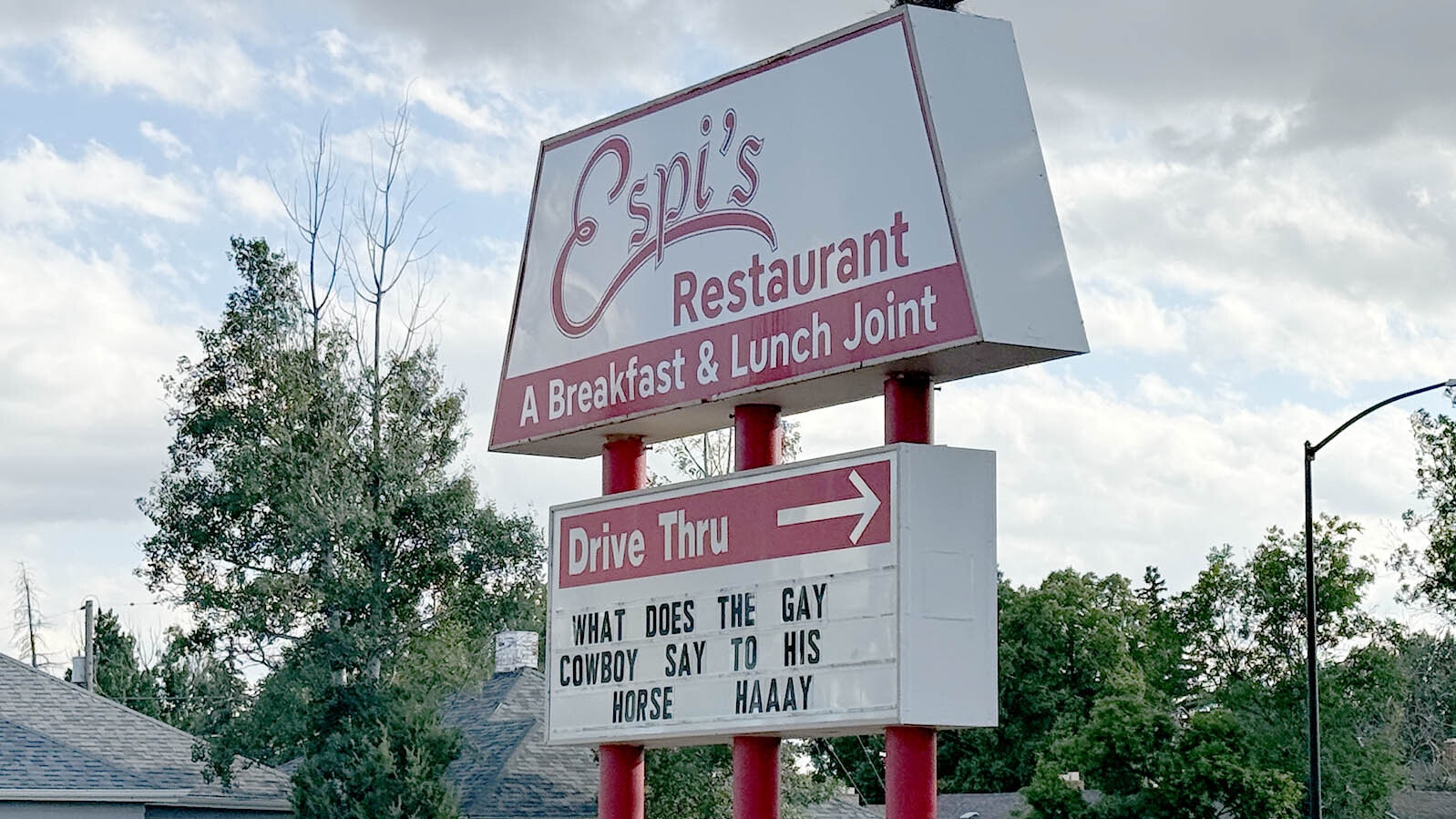When the avalanche risk is high in Jackson Hole, there’s a pack of superheroes ready for action on a moment’s notice to find and rescue buried skiers and snowmobilers.
These superheroes don’t wear capes, they wear collars. And, like a superhero, they’re ski-slope celebrities with their own trading cards and draw attention everywhere they go at Jackson Hole Mountain Resort.
They are the Jackson Hole Mountain Resort Ski Patrol’s avalanche dogs, and though they may not know it themselves, they are crucial members of the team when it comes to emergency search and rescue missions in the Jackson Hole area.
Meet The Dogs
• Levi, owned by Heather Munn, is a border collie mix weighing 56 pounds, whose superpowers are tug and fetch.
• Sockdolager, or Dolly for short, owned by Tyler Babcock, is an Australian cattle dog weighing 38 pounds, whose superpower is swimming.
• Toby, owned by Matt Kaso, is an English shepherd weighing 47 pounds, whose superpowers include being fluffy.
• Sparrow, owned by Peter Linn, is an Airedale weighing 45 pounds, whose superpowers include meditation.
• Cache, owned by Chris Brindisi, is a Dutch shepherd, weighing 43 pounds, whose superpowers include playful mischief, tug of war and fetch.
Cache and Levi are certified avalanche dogs, while the other three are avalanche dogs in training.

Ready For Action
The avalanche dog team’s primary responsibility is to be ready at all times to search Jackson Hole Mountain Resort’s ski areas — but if an avalanche happens on the Idaho side of the Tetons or somewhere else within helicopter reach, it’s not out of bounds that the dogs and their owners will pick up and go to help, dog handler Kaso told Cowboy State Daily.
“We’re going to be ready to go at the drop of a hat,” he said. “They’ll take us over to that avalanche site, totally out of our world, and use our search dogs.”
The avalanche dogs also regularly train with other agencies like Teton County Search and Rescue, the National Park Service, and the U.S. Forest Service. That way they know everyone and ready to go basically any time to anywhere needed, with no distractions.
“Technically we’re not required to go into the park or the Forest Service land on the other side of our boundaries, but obviously we can and we will,” Kaso said. “And in our search and rescue team, we work with them pretty closely.
“They’re awesome to have and, you know, it’s a lot easier from a medical side to respond to an injured person in the backcountry and then have search and rescue pick them up with the helicopter as opposed to running them out with a sled.”
The Right Stuff
Dogs have long been part of Teton County when it comes to search and rescue, going back to 1979 and one Peter MacKay.
Mackay recalls being visited by a woman named Sandy Bryson just before 1979. She was a pioneer in the field of search dog training and wrote one of the first books on the topic.
Even though MacKay was initially skeptical and not all that impressed by her demonstration, he nonetheless saw the potential and picked up a Labrador puppy not long after.
One year later, MacKay was ready to give a little demonstration of his own on what a search and rescue dog can do at Laramie Cliffs. A large snowslide down the bowl had made ideal conditions for him to demonstrate how rapidly a dog can find a human buried in the snow.
So, MacKay buried a co-worker in the snow for the demonstration, and a large and curious crowd gathered to watch. Among them were some fairly skeptical members of the Teton County Sheriff’s Department, some of whom didn’t believe that this was going to work well at all.
MacKay and his Labrador proved all the skeptics wrong in very short order. The Jackson Hole avalanche dog program was born, and it’s been going strong since.
Most of the time, there’s no emergency work for these dogs to do, thanks to all the avalanche mitigation measures that are taken inside the Jackson Hole Mountain Resort. These include patrolling likely avalanche paths daily and setting off small charges — snow grenades basically — to trigger slides before skiers do.
But the dogs still work every day. They engage in daily drills to keep their skills and training sharp, as well as acting like the all-around irresistible ambassadors for the resort that they are.
A Pins And Needles Kind Of Season
One thing that makes dogs so good at search and rescue is their keen sense of smell. Their noses are 100,000 times more sensitive than a human’s, and the part of a dog’s brain that interprets smells is seven times larger than a human being’s, according to the American Kennel Club.
And, while there are animals that have a better sense of smell, none of those animals has the sociability and trainability of a dog. That makes dogs ideal companions for a serious search and rescue team.
But as serious as the search and rescue team mission is, for the dogs it’s really all about the fun. They don’t know their roles are life-and-death at all.
It’s the owners’ job to do all the worrying for the dogs — and worry their owners do, particularly in years like this when conditions have been ripe all season for avalanches.
“We got that early snow, and then it didn’t snow for a long time,” Kaso told Cowboy State Daily. “In layman’s terms, that snow turns to sugar down there when it’s just clear and cold for so many weeks.”
Crumbly grains of icy sugar don’t have much staying power on a steep mountain slope. Once that sugar layer gets covered up by heavier, cake-like layers of snow, the whole mountainside is like a house of cards. It only takes one wrong move to bring it all down at once.
Once that happens, it is very difficult to escape an avalanche, even for experts. Avalanches can reach 80 mph within a few seconds. Compare that with the average speed for the last three Olympic downhill ski winners, which were in the mid to low 60 mph range.
That makes burial a likely scenario, even for experienced skiers who get caught in an avalanche.
This year’s high-risk conditions have had everyone on alert since the season began.
“For a while there, in the early season, when it finally started to snow, it kind of felt like we were just waiting on pins and needles, you know, for that call to come through that there’s been a big avalanche right outside the boundary,” Kaso said. “Thankfully, for the most part, I feel like we’ve dodged some bullets and hopefully, knock on wood, all’s well.
“We seem to have gotten enough snow the last three, four weeks that we’re hopefully building a bridge over that weak layer. Things are trending to the more positive side of things.”
Not Time To Relax Yet
While the risks might be lower, that doesn’t mean there’s been any relaxation on the part of the JHMR Ski Patrol and its five avalanche dogs and handlers.
“We’ve got to keep our hackles up,” Kaso said.
From where he was sitting atop Rendezvous Mountain in Corbett’s Cabin on Monday morning, he could see the results of an overnight avalanche near what the JHMR Ski Patrol refers to as No Name Peak.
“It was a big avalanche, anywhere from, you know, 5- to 5-foot crown, which, it basically took all the snow to the bare rock,” Kaso said. “So, it’s still happening out there, and it’s still scary, even if it’s trending to a better, more stable snowpack.”
That particular avalanche didn’t trigger a search-and-rescue mission, since it happened overnight during a snowstorm when no one would have been in that area.
Nonetheless, Kaso knows members of the ski patrol, out of an abundance of caution, checked for signals from avalanche beacons as they skied by the area, just to be sure no one got buried underneath all that snow.
A fully charged avalanche beacon is a safety device cross-country skiers or snowmobilers can wear that will transmit a signal for up to a week, Kaso said. Those have become more common as the popularity of backcountry skiing has continued to rise.
The beacons, though, don’t negate the need for rescue dogs.
For one, not all skiers have beacons, Kaso said. And sometimes, even those who do have them forget to turn them on.
That was the case for a body recovery in 2020 on Taylor Mountain, when a snowboarder was caught and carried in an avalanche, and then buried beneath the snow.
Rescuers were not able to find him in time to save his life.
The next day, Linn’s dog Goose, a border collie since retired, was brought to the scene to recover the man’s body.
The dog was able to find the body in about three minutes. That meant a much shorter duration for the searchers, who were still at risk in the area, despite earlier heli-bombing missions meant to lower the risk of an avalanche.
Party Like A Cheerleader
The speed with which rescue dogs can find a buried human is one of their biggest advantages out in the field.
A dog can search a 2.5-acre area in about 30 minutes, while it can take 20 people about eight times longer to search the same area.
Training an avalanche dog, however, is anything but speedy. It’s a process that begins when the dog is just a puppy and takes from one to as many as three years to reach certification.
Not all dogs are suitable for the work, either.
“After about three years, if it’s not working out, you should have a serious conversation with yourself and the rest of your teammates on moving forward,” Kaso said. “Generally speaking, that doesn’t happen too often — if you did your due diligence when it was a puppy and picked a good puppy from a good litter.”
Hunting dogs are the breeds generally most suited to this type of work, Kaso added. His dog, Toby, is an English shepherd.
“Even before he needed to start any specific avalanche training, I just had (Toby) out here getting to know the workers and riding the chairlift and seeing the locker room — all the things that kind of go along with being out here at the ski resort,” Kaso said.
Once the puppy is old enough and well behaved enough, the real training begins, but it wouldn’t seem like training to most people.
“We just kind of start off with baby steps,” Kaso said. “You know, you’re holding on to the dog and the worker, you know, waves the toy in front of them and gets them all ramped up, ginned up it’s called.”
The dog grabs the toy and starts the big tug of war that will one day be its main reward on a search and rescue scene.
“It’s a big reward, and you try and get those dogs addicted to that reward with high-pitched squeals, you know, like a cheerleader that’s had a couple too many drinks,” Kaso said. “And the dogs love it.”
Ramping Up To The Rock Star Life
Once the reward system is solid, the training kicks up a notch, with someone running away with the toy, taunting the dog a bit and getting him to chase after.
At some point, that running person will jump into a trench, throwing a bit of snow on top so that they’re not immediately visible.
“The dog’s going in there to get that party, to get its toy, but we kind of almost tricked it into using its nose and it associates that human scent with that party, with that reward,” Kaso said. “And you gradually, as the dog gets more experienced, just keep taking it up a notch.”
Eventually, the dog is so into the game and knows it so well, that he’s ready for a big milestone — certification as an avalanche dog.
He’ll be tasked with finding a human body that’s been buried 3 feet under the snow. And the way that burial gets done is kind of interesting.
An inflatable tube is first buried under the snow. After that sets up for a few days, the tube is removed and an air valve connected to the hole so that a person inside this little hot-dog ice cave can breathe comfortably as they wait for the dogs taking their test to find them.
If the dogs are successful, they have a rock star kind of life ahead of them — trading cards and chew toy parties every day — as they help ensure that ski bums, snowmobilers and snowshoers can keep on living the dream in Jackson Hole.
Renée Jean can be reached at Renee@CowboyStateDaily.com

